Trumpet honeysuckle (
Lonicera sempervirens) is an adaptable and well-behaved vine native to woodland edges in the eastern U.S. that will grow in any moisture-retentive soil with plenty of sun. Unlike Chinese and Japanese wisteria (
Wisteria sinensis and
W. floribunda), trumpet creeper (
Campsis radicans) and other flowering vines commonly used for scrambling over arbors or up porch rails, trumpet honeysuckle is unlikely to become invasive or damage nearby structures.
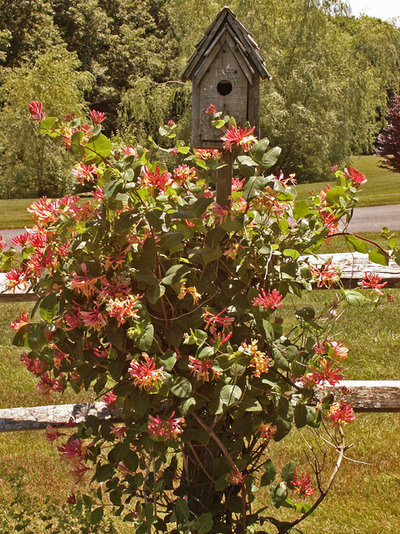
Ellen Sousa/Turkey Hill Brook Farm
Botanical name: Lonicera sempervirensCommon names: Trumpet honeysuckle (for the way flower petal ends flare outward like a trumpet), coral honeysuckle
Origin: Native to the East Coast from Connecticut west to Ohio and Oklahoma, south to Florida and Texas
Where it will grow: Hardy to -30 degrees Fahrenheit (USDA zones 4 to 9; find your zone)
Water requirement: Needs consistent soil moisture in the first few years, but fairly drought-tolerant once established
Light requirement: Full sun for season-long blooms but will grow and bloom more sparsely in part-shade
Mature size: Woody vine with twining stems that grow 4 to 15 feet long and 4 to 8 feet wide
Benefits and tolerances: Non-invasive ornamental vine to weave through a trellis, pergola or arbor; foliage is deer-resistant; flowers are an important nectar source for hummingbirds and native bees; yellow-orange berries are eaten by birds; plant is a host plant for many butterfly and moth species
Seasonal interest: Bright clusters of red, yellow or coral-colored flowers through the season; semi-evergreen foliage in warmer zones
When to plant: Spring through fall
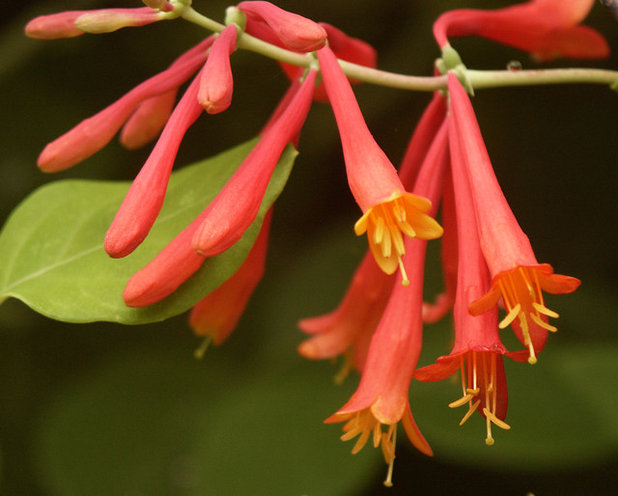
Ellen Sousa/Turkey Hill Brook Farm
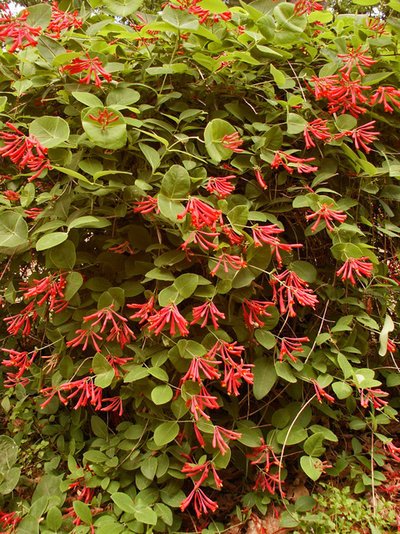
Ellen Sousa/Turkey Hill Brook Farm
Distinguishing traits. One of our longest-blooming flowering plants, trumpet honeysuckle begins the season with a heavy flush of spring blooms, then continues flowering from stem tips through the season, often continuing through late fall.
Notice how the long tubular flower corollas are perfectly sized and shaped to accommodate the long beak and tongue of a hummingbird, which is one of its primary pollinators. Only pollinators with a long tongue can reach the sweet nectar hidden deep inside these tubes, in the process picking up and distributing pollen to other flowers. Honeysuckle depends upon the presence of hummingbirds and other local long-tongued pollinators such as bumble bees, mason bees and leafcutter bees to set seed and ensure species survival.
Don’t confuse trumpet honeysuckle with the non-native and highly invasive Asian honeysuckles that are taking over natural areas in the eastern U.S. Nurseries still sell some of these invasive honeysuckles (or hybrids of them), so check labels carefully and avoid buying
Lonicera japonica,
L. morrowii or
L. tatarica.
Trumpet honeysuckle is also sometimes confused with trumpet creeper vine (Campsis radicans), which also is an eastern native vine with red-orange flowers but is more aggressive, difficult to eradicate and capable of damaging structures it is grown near. Always carefully check the botanical names on plant labels so you don’t buy something you’ll later regret.
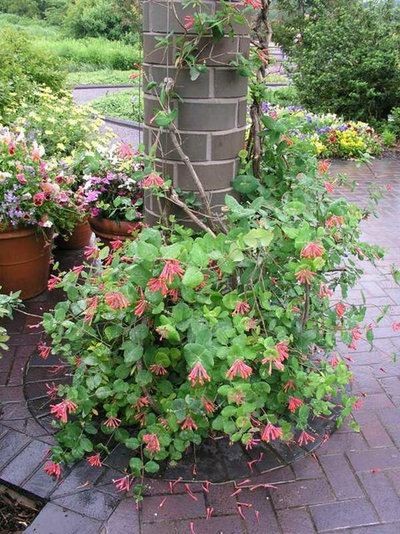
Missouri Botanical Garden
How to use it. Use trumpet honeysuckle to climb a garden structure, cover a tree stump or billow shrub-like over a patio wall for your own hummingbird-viewing station. Provide some form of support (string, netting or a trellis) and trumpet honeysuckle will happily climb up a porch rail, fence post or any other structure you need covered.
Planting notes. Trumpet honeysuckle is easy to propagate in summer from an existing plant. Pin a green, vigorous non-flowering stem (with two to three nodes) to the surface of a wide container of potting medium and water regularly until roots establish from the nodes. To grow from seed, collect berries as they ripen, extract the seeds (let fruits air dry for a week or two until they become shriveled and raisin-like, then remove the tiny seed), rinse them clean with water, and sow immediately outdoors. Be patient; the seeds tend to germinate only after several cycles of cold stratification, and in northern areas they may not begin to germinate until mid-summer.
Trumpet honeysuckle can be pruned at any time of year to control height or growth, but winter pruning will remove spring flower buds. Each vine needs initial support to climb, but mature plants can support themselves with their woody stems. To use for screening purposes, allow suckers to grow from the base to intertwine with older stems to form a thick wall. Once established, you can occasionally prune stems to the ground to control size where necessary.
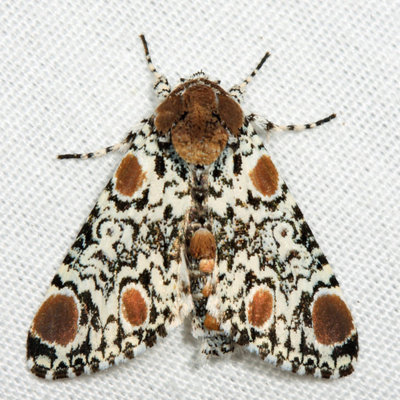 Pollinator notes.
Pollinator notes. Trumpet honeysuckle is a host plant for several species of butterfly and moth caterpillars, including the spring azure (
Celastrina ladon), the day-flying snowberry clearwing moth (
Hemaris diffinis), the great tiger moth (
Arctia caja) and the Harris’ three-spot moth (
Harrisimemna trisignata) shown here, a moth that is a master of disguise throughout its life cycle.
Like many specialist native insects, this unique moth has adapted effective methods to survive in a tough world. The adult moth looks like a tree lichen, making it almost invisible to predators searching for a quick meal. Young caterpillars look just like a bird dropping — not very appetizing even to a hungry bird. The caterpillars retain their heads from previous molts and violently shake these heads to fend off any threatening attacker.
More: Learn more about gardening with native plants in your area
Discover more vines to grow in your garden





